steering TOYOTA MIRAI 2022 Manual PDF
[x] Cancel search | Manufacturer: TOYOTA, Model Year: 2022, Model line: MIRAI, Model: TOYOTA MIRAI 2022Pages: 556, PDF Size: 17.34 MB
Page 318 of 556

3185-5. Using the driving support systems
Owners Manual_USA_M62084_en
■Operating conditions of Active
Cornering Assist
The system operates when the fol-
lowing occurs.
●TRAC/VSC can operate
●The driver is at tempting to accel-
erate while turning
●The system detects that the vehi-
cle is drifting to the outer side
●The brake pedal is released
■Reduced effectiveness of the
EPS system
The effectiveness of the EPS sys-
tem is reduced to prevent the sys-
tem from overheating when there is
frequent steering input over an
extended period of time. The steer-
ing wheel may feel heavy as a
result. Should this occur, refrain
from excessive steering input or
stop the vehicle and turn the fuel
cell system off. The EPS system
should return to normal within 10
minutes.
■Secondary Collision Brake
operating conditions
The system operates when the SRS
airbag sensor detects a collision
while the vehicle is in motion. How-
ever, the system does not operate in
any of the following situations.
●When driving at a low speed
●Components are damaged
■Secondary Collision Brake
automatic cancelation
The system is automatically can-
celed in any of th e following situa-
tions.
●The vehicle speed has decreased
to a certain speed
●A certain amount o f time elapses
during operation
●The accelerator pedal is
depressed a large amount
WARNING
■The ABS does not operate
effectively when
●The limits of tire gripping perfor-
mance have been exceeded
(such as excessively worn tires
on a snow covered road).
●The vehicle hydroplanes while
driving at high speed on wet or
slick roads.
■Stopping distance when the
ABS is operating may exceed
that of normal conditions
The ABS is not designed to
shorten the vehicle’s stopping dis-
tance. Always maintain a safe dis-
tance from the veh icle in front of
you, especially in the following sit-
uations:
●When driving on dirt, gravel or
snow-covered roads
●When driving with tire chains
●When driving over bumps in the
road
●When driving over roads with
potholes or uneven surfaces
■TRAC/VSC may not operate
effectively when
Directional control and power may
not be achievable while driving on
slippery road surfaces, even if the
TRAC/VSC system is operating.
Drive the vehicle carefully in con-
ditions where stability and power
may be lost.
■Active Cornering Assist does
not operate effectively when
●Do not overly rely on Active
Cornering Assist. Active Corner-
ing Assist may not operate
effectively when accelerating
down slopes or driving on slip-
pery road surfaces.
Page 320 of 556
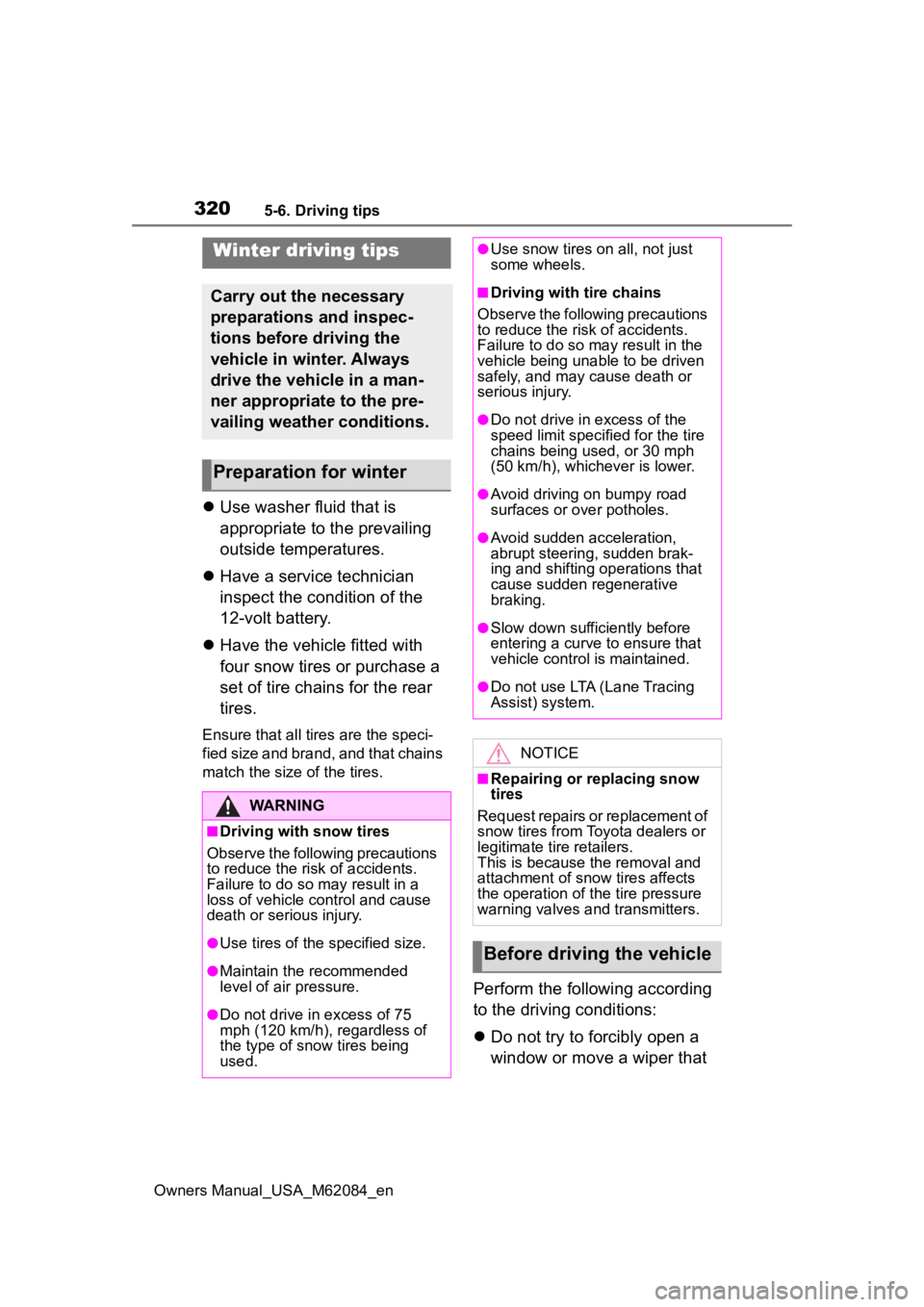
3205-6. Driving tips
Owners Manual_USA_M62084_en
5-6.Driving tips
Use washer fluid that is
appropriate to the prevailing
outside temperatures.
Have a service technician
inspect the condition of the
12-volt battery.
Have the vehicle fitted with
four snow tires or purchase a
set of tire chains for the rear
tires.
Ensure that all tires are the speci-
fied size and brand, and that chains
match the size of the tires.
Perform the following according
to the driving conditions:
Do not try to forcibly open a
window or move a wiper that
Winter driving tips
Carry out the necessary
preparations and inspec-
tions before driving the
vehicle in winter. Always
drive the vehicle in a man-
ner appropriate to the pre-
vailing weather conditions.
Preparation for winter
WARNING
■Driving with snow tires
Observe the following precautions
to reduce the risk of accidents.
Failure to do so m ay result in a
loss of vehicle control and cause
death or serious injury.
●Use tires of the specified size.
●Maintain the recommended
level of air pressure.
●Do not drive in excess of 75
mph (120 km/h), regardless of
the type of snow tires being
used.
●Use snow tires on all, not just
some wheels.
■Driving with tire chains
Observe the following precautions
to reduce the risk of accidents.
Failure to do so may result in the
vehicle being unable to be driven
safely, and may cause death or
serious injury.
●Do not drive in excess of the
speed limit specifi ed for the tire
chains being used, or 30 mph
(50 km/h), whichever is lower.
●Avoid driving on bumpy road
surfaces or over potholes.
●Avoid sudden acceleration,
abrupt steering, sudden brak-
ing and shifting operations that
cause sudden regenerative
braking.
●Slow down sufficiently before
entering a curve to ensure that
vehicle control is maintained.
●Do not use LTA (Lane Tracing
Assist) system.
NOTICE
■Repairing or replacing snow
tires
Request repairs or replacement of
snow tires from Toyota dealers or
legitimate tire retailers.
This is because the removal and
attachment of snow tires affects
the operation of the tire pressure
warning valves and transmitters.
Before driving the vehicle
Page 323 of 556

323
Owners Manual_USA_M62084_en
6
6
Interior features
Interior features
6-1. Using the air conditioning system and defogger
ALL AUTO control ....... 324
Automatic air conditioning system (vehicles with 8-
inch display) .............. 325
Automatic air conditioning system (vehicles with 12.3-
inch display) .............. 332
Rear automatic air condi- tioning system ........... 341
Heated steering wheel/seat heaters/seat ventilators.................................. 342
6-2. Using the interior lights Interior lights list .......... 346
6-3. Using the storage features List of storage features 349
Trunk features ............. 352
6-4. Using the other interior features
Toyota multi-operation touch (vehicle with the 12.3-inch
display) ...................... 353
Electronic sunshade.... 355
Other interior features . 356
Garage door opener.... 371
Page 324 of 556
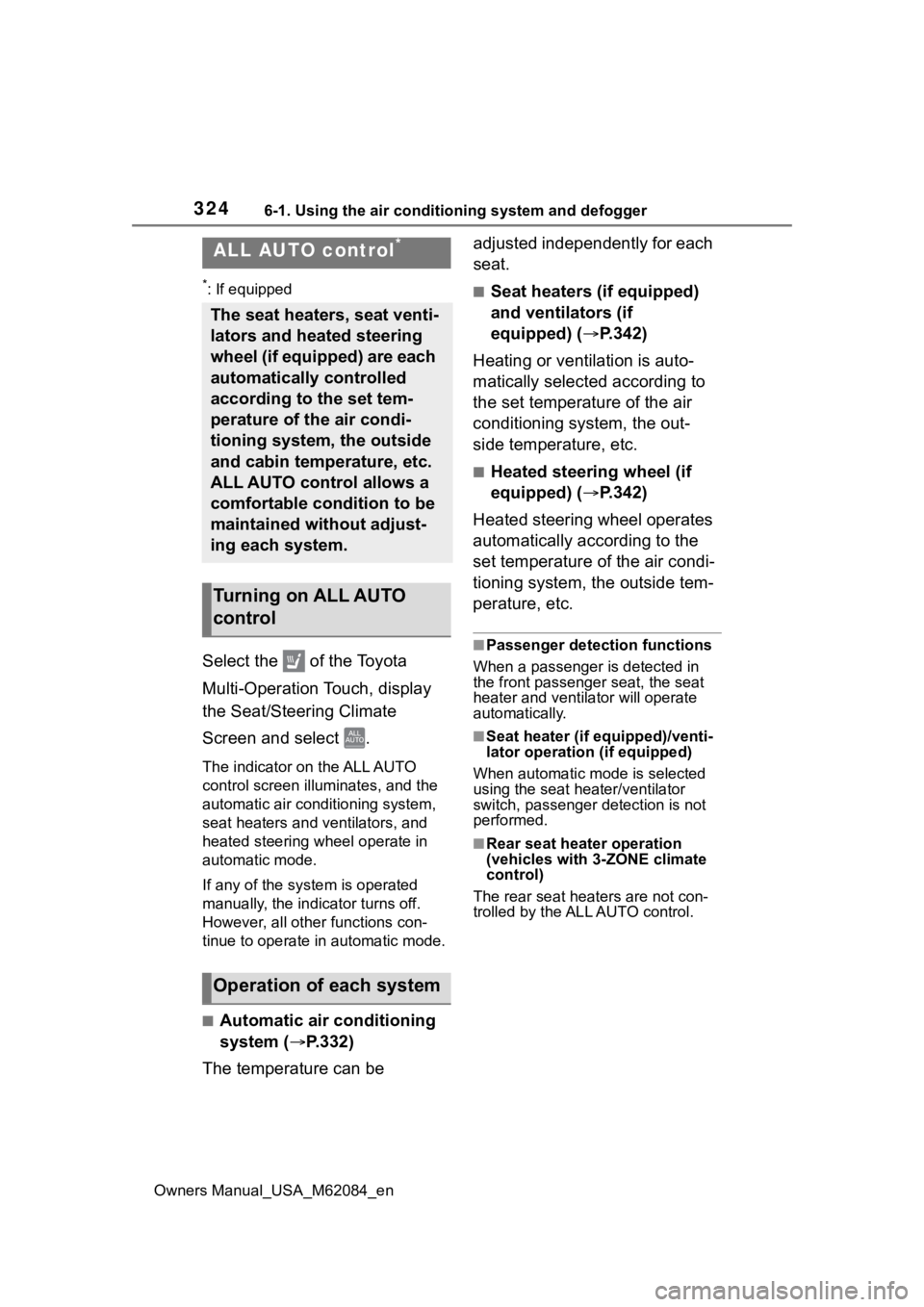
3246-1. Using the air conditioning system and defogger
Owners Manual_USA_M62084_en
6-1.Using the air conditioning system and defogger
*: If equipped
Select the of the Toyota
Multi-Operation Touch, display
the Seat/Steering Climate
Screen and select .
The indicator on the ALL AUTO
control screen illuminates, and the
automatic air conditioning system,
seat heaters and v entilators, and
heated steering wheel operate in
automatic mode.
If any of the system is operated
manually, the indicator turns off.
However, all other functions con-
tinue to operate in automatic mode.
■Automatic air conditioning
system ( P.332)
The temperature can be adjusted independently for each
seat.
■Seat heaters (if equipped)
and ventilators (if
equipped) (
P.342)
Heating or ventilation is auto-
matically selected according to
the set temperature of the air
conditioning system, the out-
side temperature, etc.
■Heated steering wheel (if
equipped) ( P.342)
Heated steering wheel operates
automatically according to the
set temperature of the air condi-
tioning system, the outside tem-
perature, etc.
■Passenger detection functions
When a passenger is detected in
the front passenger seat, the seat
heater and ventila tor will operate
automatically.
■Seat heater (if equipped)/venti-
lator operation (if equipped)
When automatic mode is selected
using the seat heater/ventilator
switch, passenger d etection is not
performed.
■Rear seat heater operation
(vehicles with 3-ZONE climate
control)
The rear seat heaters are not con-
trolled by the ALL AUTO control.
ALL AUTO control*
The seat heaters, seat venti-
lators and heated steering
wheel (if equipped) are each
automatically controlled
according to the set tem-
perature of the air condi-
tioning system, the outside
and cabin temperature, etc.
ALL AUTO control allows a
comfortable condition to be
maintained without adjust-
ing each system.
Turning on ALL AUTO
control
Operation of each system
Page 342 of 556
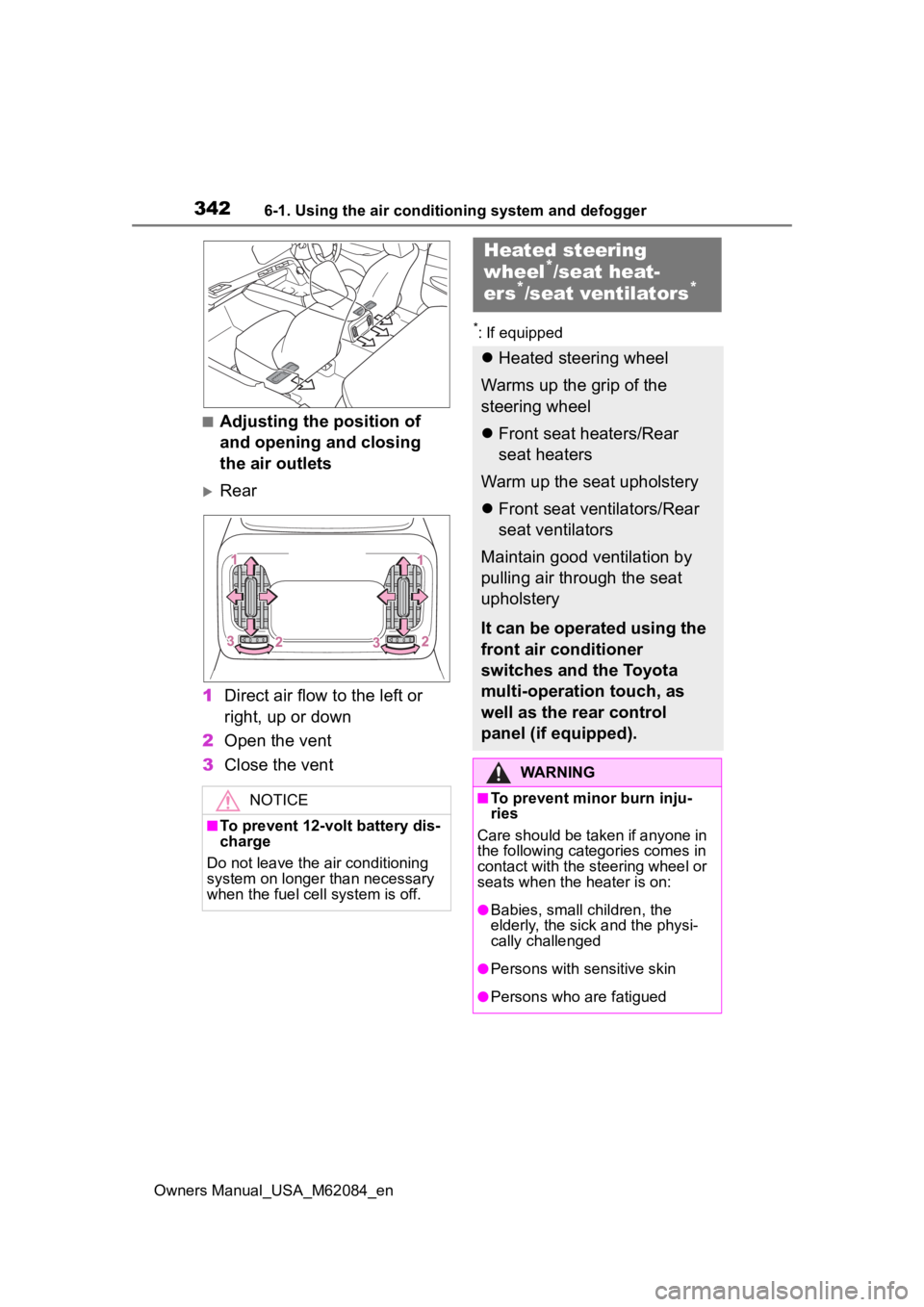
3426-1. Using the air conditioning system and defogger
Owners Manual_USA_M62084_en
■Adjusting the position of
and opening and closing
the air outlets
Rear
1 Direct air flow to the left or
right, up or down
2 Open the vent
3 Close the vent
*: If equipped
NOTICE
■To prevent 12-volt battery dis-
charge
Do not leave the air conditioning
system on longer than necessary
when the fuel cell system is off.
Heated steering
wheel*/seat heat-
ers*/seat ventilators*
Heated steering wheel
Warms up the grip of the
steering wheel
Front seat heaters/Rear
seat heaters
Warm up the seat upholstery
Front seat ventilators/Rear
seat ventilators
Maintain good ventilation by
pulling air through the seat
upholstery
It can be operated using the
front air conditioner
switches and the Toyota
multi-operation touch, as
well as the rear control
panel (if equipped).
WARNING
■To prevent minor burn inju-
ries
Care should be taken if anyone in
the following categories comes in
contact with the steering wheel or
seats when the heater is on:
●Babies, small children, the
elderly, the sick and the physi-
cally challenged
●Persons with sensitive skin
●Persons who are fatigued
Page 343 of 556
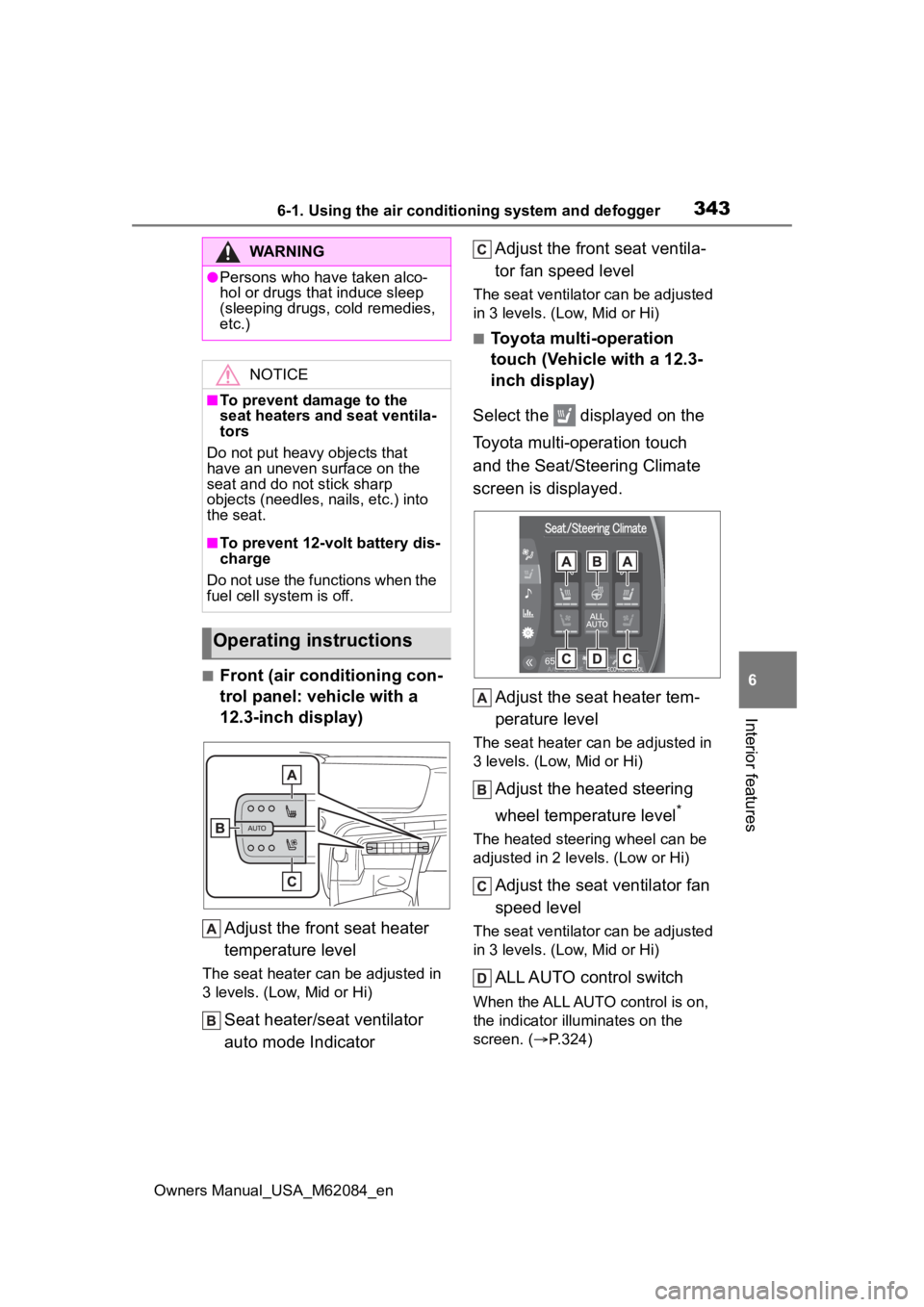
3436-1. Using the air conditioning system and defogger
Owners Manual_USA_M62084_en
6
Interior features
■Front (air conditioning con-
trol panel: vehicle with a
12.3-inch display) Adjust the front seat heater
temperature level
The seat heater can be adjusted in
3 levels. (Low, Mid or Hi)
Seat heater/seat ventilator
auto mode Indicator Adjust the front seat ventila-
tor fan speed level
The seat ventilator can be adjusted
in 3 levels. (Low, Mid or Hi)
■Toyota multi-operation
touch (Vehicle with a 12.3-
inch display)
Select the displayed on the
Toyota multi-operation touch
and the Seat/Steering Climate
screen is displayed.
Adjust the seat heater tem-
perature level
The seat heater c an be adjusted in
3 levels. (Low, Mid or Hi)
Adjust the heated steering
wheel temperature level
*
The heated steering wheel can be
adjusted in 2 le vels. (Low or Hi)
Adjust the seat ventilator fan
speed level
The seat ventilator can be adjusted
in 3 levels. (Low, Mid or Hi)
ALL AUTO control switch
When the ALL AUTO control is on,
the indicator illu minates on the
screen. ( P.324)
WARNING
●Persons who have taken alco-
hol or drugs that induce sleep
(sleeping drugs, cold remedies,
etc.)
NOTICE
■To prevent damage to the
seat heaters and seat ventila-
tors
Do not put heavy objects that
have an uneven surface on the
seat and do not stick sharp
objects (needles, nails, etc.) into
the seat.
■To prevent 12-volt battery dis-
charge
Do not use the functions when the
fuel cell system is off.
Operating instructions
Page 344 of 556

3446-1. Using the air conditioning system and defogger
Owners Manual_USA_M62084_en
■Rear control panel (if
equipped)Adjust the rear seat heater
temperature level
The seat heater can be adjusted in
3 levels. (Low, Mid or Hi)
Adjust the rear right side seat
ventilator fan speed level
The seat ventilator can be adjusted
in 3 levels. (Low, Mid or Hi)
Indicators
■The heated steering wheel, seat
heaters and seat ventilators can
be used when
The power swit ch is in ON.
■Air conditioning system-linked
control mode
When the seat ventilator fan speed
level is Hi, the s eat ventilator fan
speed becomes higher according to
the fan speed of the air conditioning
system.
■When the air conditioning sys-
tem is operating in S-FLOW
mode
If a passenger is not detected in the
passenger seat, the seat ventilator
and seat heater of the passenger’s
seat will be turne d off if on.
( P.338)
■Change settings for the rear
control panel
The following settings can be
changed.
• Reaction time after touching the button.
• Turn button operation sounds ON/OFF
1 Stop the vehicle in a safe place
and stop the fuel cell system.
2 Press the power switch 1 time
with brake pedal released and
switch the mode to ACC.
The setting cannot be changed
when the power switch is ON.
3 Press for 10 seconds or
more while pressing the but-
ton.
4 Release the button after the
buzzer sounds.
5 Select customizable item
Change the reaction time for button
operations:
When is pressed it becomes
faster, when is pressed it
becomes slower.
Change the button operation
sounds ON/OFF
When is pressed it turns ON,
when is pressed it turns OFF.
6 When changes are complete, the
indicators for the seat
heater/seat ventilator turns on as
shown in the following table.
Page 383 of 556
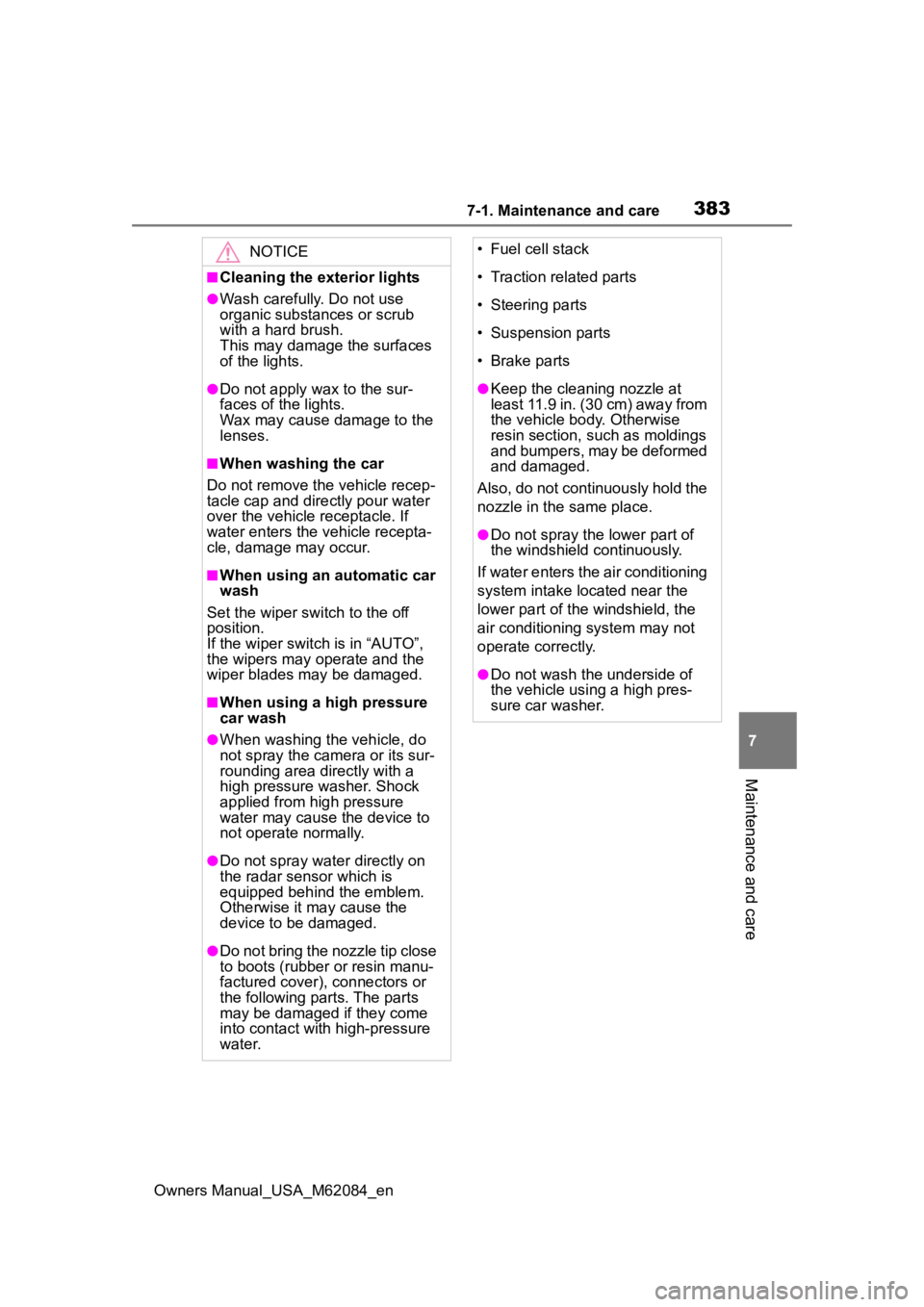
3837-1. Maintenance and care
Owners Manual_USA_M62084_en
7
Maintenance and care
NOTICE
■Cleaning the exterior lights
●Wash carefully. Do not use
organic substances or scrub
with a hard brush.
This may damage the surfaces
of the lights.
●Do not apply wax to the sur-
faces of the lights.
Wax may cause damage to the
lenses.
■When washing the car
Do not remove the vehicle recep-
tacle cap and directly pour water
over the vehicle receptacle. If
water enters the vehicle recepta-
cle, damage may occur.
■When using an automatic car
wash
Set the wiper switch to the off
position.
If the wiper switch is in “AUTO”,
the wipers may operate and the
wiper blades may be damaged.
■When using a high pressure
car wash
●When washing the vehicle, do
not spray the came ra or its sur-
rounding area directly with a
high pressure washer. Shock
applied from high pressure
water may cause the device to
not operate normally.
●Do not spray water directly on
the radar sensor which is
equipped behind the emblem.
Otherwise it may cause the
device to be damaged.
●Do not bring the nozzle tip close
to boots (rubber or resin manu-
factured cover), connectors or
the following parts. The parts
may be damaged if they come
into contact with high-pressure
water.
• Fuel cell stack
• Traction related parts
• Steering parts
• Suspension parts
• Brake parts
●Keep the cleaning nozzle at
least 11.9 in. (30 cm) away from
the vehicle body. Otherwise
resin section, s uch as moldings
and bumpers, may be deformed
and damaged.
Also, do not continuously hold the
nozzle in the same place.
●Do not spray the lower part of
the windshield continuously.
If water enters the air conditioning
system intake located near the
lower part of the windshield, the
air conditioning system may not
operate correctly.
●Do not wash the underside of
the vehicle using a high pres-
sure car washer.
Page 384 of 556
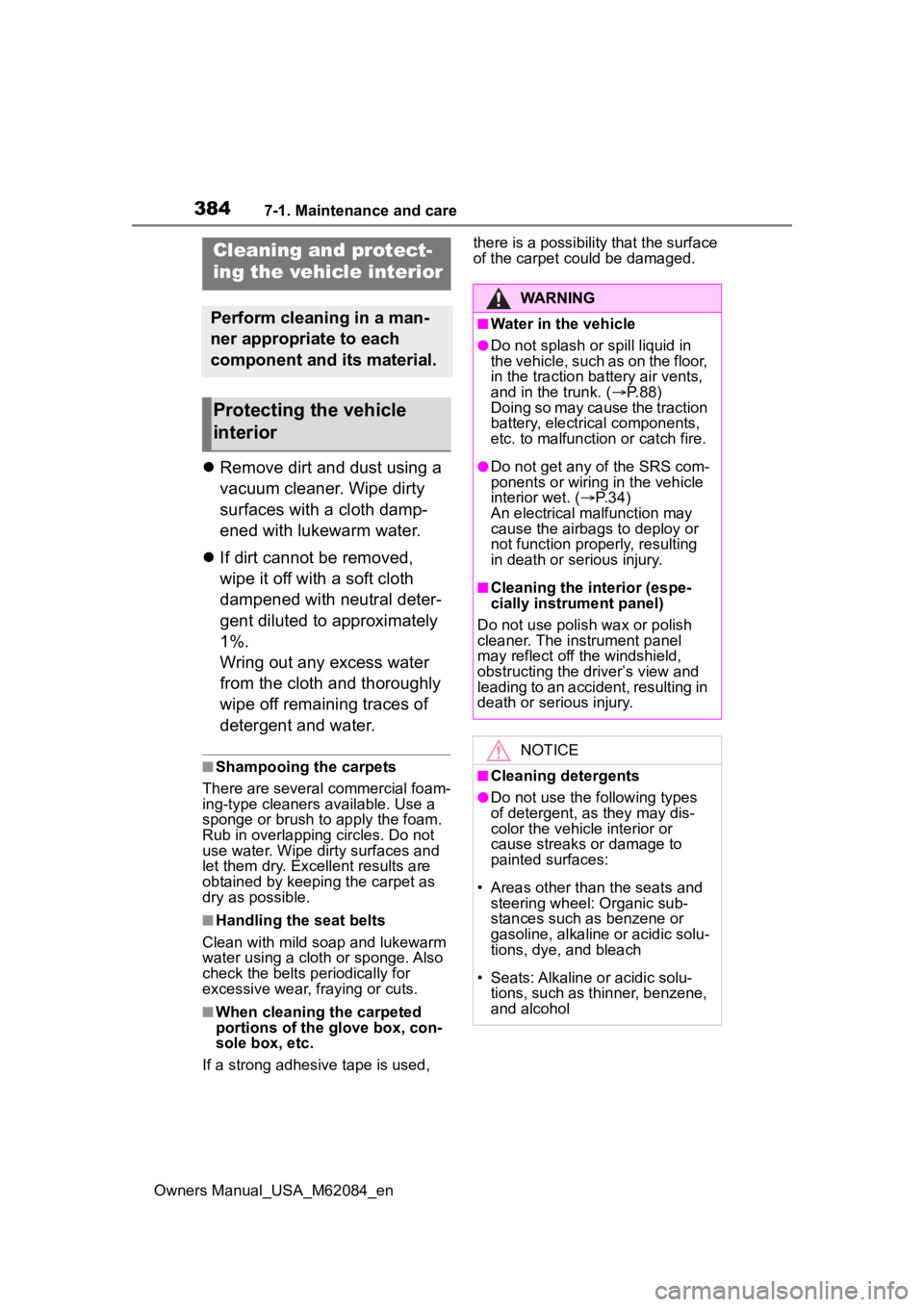
3847-1. Maintenance and care
Owners Manual_USA_M62084_en
Remove dirt and dust using a
vacuum cleaner. Wipe dirty
surfaces with a cloth damp-
ened with lukewarm water.
If dirt cannot be removed,
wipe it off with a soft cloth
dampened with neutral deter-
gent diluted to approximately
1%.
Wring out any excess water
from the cloth and thoroughly
wipe off remaining traces of
detergent and water.
■Shampooing the carpets
There are several commercial foam-
ing-type cleaners available. Use a
sponge or brush to apply the foam.
Rub in overlapping circles. Do not
use water. Wipe dirty surfaces and
let them dry. Excellent results are
obtained by keeping the carpet as
dry as possible.
■Handling the seat belts
Clean with mild soap and lukewarm
water using a cloth or sponge. Also
check the belts periodically for
excessive wear, fraying or cuts.
■When cleaning the carpeted
portions of the glove box, con-
sole box, etc.
If a strong adhesive tape is used, there is a possibility that the surface
of the carpet could be damaged.
Cleaning and protect-
ing the vehicle interior
Perform cleaning in a man-
ner appropriate to each
component and its material.
Protecting the vehicle
interior
WARNING
■Water in the vehicle
●Do not splash or spill liquid in
the vehicle, such as on the floor,
in the traction ba
ttery air vents,
and in the trunk. ( P. 8 8 )
Doing so may cause the traction
battery, electrical components,
etc. to malfunction or catch fire.
●Do not get any of the SRS com-
ponents or wiring in the vehicle
interior wet. ( P. 3 4 )
An electrical ma lfunction may
cause the airbags to deploy or
not function properly, resulting
in death or serious injury.
■Cleaning the interior (espe-
cially instrument panel)
Do not use polish wax or polish
cleaner. The instrument panel
may reflect off the windshield,
obstructing the driver’s view and
leading to an accident, resulting in
death or serious injury.
NOTICE
■Cleaning detergents
●Do not use the following types
of detergent, as they may dis-
color the vehicle interior or
cause streaks or damage to
painted surfaces:
• Areas other than the seats and steering wheel: Organic sub-
stances such as benzene or
gasoline, alkaline or acidic solu-
tions, dye, and bleach
• Seats: Alkaline or acidic solu- tions, such as th inner, benzene,
and alcohol
Page 385 of 556

3857-1. Maintenance and care
Owners Manual_USA_M62084_en
7
Maintenance and care
Remove dirt using a water-
dampened soft cloth or syn-
thetic chamois.
Wipe the surface with a dry,
soft cloth to remove any
remaining moisture.
■Cleaning the areas with satin-
finish metal accents
The metal areas use a layer of real
metal for the surface. It is necessary
to clean them regularly. If dirty areas
are left uncleaned for long periods
of time, they may be difficult to
clean.
Remove dirt and dust using a
vacuum cleaner.
Wipe off any excess dirt and
dust with a soft cloth damp-
ened with diluted detergent.
Use a diluted water solution of
approximately 5% neutral wool
NOTICE
• Steering wheel: Organic sub-
stances, such as thinner, and
cleaner that contains alcohol
●Do not use polish wax or polish
cleaner. The instrument panel’s
or other interior part’s painted
surface may be damaged.
■Preventing damage to leather
surfaces
Observe the following precautions
to avoid damage to and deteriora-
tion of leather surfaces:
●Remove any dust or dirt from
leather surfaces immediately.
●Do not expose the vehicle to
direct sunlight for extended peri-
ods of time. Park the vehicle in
the shade, especially during
summer.
●Do not place items made of
vinyl, plastic, or containing wax
on the upholstery, as they may
stick to the leather surface if the
vehicle interior heats up signifi-
cantly.
■Water on the floor
Do not wash the vehicle floor with
water.
Vehicle systems such as the
audio system may be damaged if
water comes into contact with
electrical components such as the
audio system above or under the
floor of the vehicle. Water may
also cause the body to rust.
■When cleaning the inside of
the windshield
Do not allow glass cleaner to con-
tact the lens. Also, do not touch
the lens. ( P.207)
■Cleaning the inside of the rear
window
●Do not use glass cleaner to
clean the rear window, as this
may cause damage to the rear
window defogger heater wires
or antenna. Use a cloth damp-
ened with lukewarm water to
gently wipe the window clean.
Wipe the window in strokes run-
ning parallel to the heater wires
or antenna.
●Be careful not to scratch or
damage the heater wires or
antenna.
Cleaning the areas with
satin-finish metal accents
Cleaning the leather areas